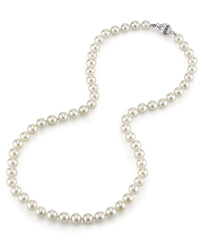
Japanese Akoya White Pearl Necklace, 6.5-7.0mm - AAA Quality
$1,540.00 Sale: $1,232.00

It’s hard to resist the allure of pearls. And within this category of gems, it’s baroque pearls with their organic shapes and luminous luster that many pearl lovers find most enchanting.
When we talk of baroque pearls, we are actually talking of a pearl shape rather than a different type of pearl. Baroque pearls have an organic shape and many are not symmetrical.
It is this imperfection that defines their beauty. In fact, many jewelry designers find brilliant sparks of inspiration in the free-form shapes of baroque pearls.
While in the past, the perfectly symmetrical pearl was seen as the ideal pearl, attitudes towards pearl shapes have changes over the years. Worn in different jewelry pieces, today baroque pearls are loved for their unique, one of a kind shapes and the air of chic individuality they bestow on the wearer.
Both bead-nucleated freshwater and South Sea pearl harvests yield many gorgeous baroque pearls. Since both types of pearls have large sizes, are lustrous and come in variety of colors, pearl lovers often find it difficult to choose between the two.

From left to right: 13-16mm Freshwater Baroque White Pearl Necklace, 15mm Pink Freshwater Baroque Pearl Solitaire Designer Pendant, 13-16mm Multicolor Freshwater Baroque Pearl Necklace, 13-16mm Freshwater Baroque Pearl Opera Length Necklace, Freshwater Baroque Pearl Dangling Tincup Earrings, Pearls of Joy
When choosing a piece of baroque pearl jewelry, here are some important value factors to keep in mind.
The more lustrous a baroque pearl, the more valuable it will be. This is true for both freshwater and South Sea pearls. And both pearls boast very beautiful and extremely striking luster.
However, there is a difference in the quality of luster between them. South Sea pearls, both white and golden, exhibit a satiny luster which has an elegant and opulent quality to it.
By contrast, bead-nucleated freshwater pearls dazzle with their high wattage, almost metallic luster. Some freshwater baroque pearls, which have rippled surfaces can exhibit a mix of satiny and metallic luster, making them quite extraordinary.
Color is an important criteria for selecting baroque pearls, both freshwater and South Sea.
White baroque South Sea pearls can be found in alluring colors which include silvery white as well as creamy white. A very rare and highly coveted baroque white South Sea pearl will have blue and sometimes even gold highlights.
Golden baroque South Sea pearls that show strong pink or green overtones when light hits them at different angles are one of the most desirable baroque pearls. Also, darker gold baroque pearls find many more admirers as compared to lighter gold baroque pearls.
Freshwater baroque pearls tell their own story in a large palette of colors with bold and strong overtones.
These pearls can come in a range of very attractive natural colors, including white, pink, lavender, peach, bronze as well as gold. In some pearls, it’s possible to see overtones of green and blue as well as purple.
With such a medley of colors, it’s no wonder that pearl lovers find themselves being pulled towards freshwater baroque pearls.

A Gorgeous Gem Quality Freshwater Baroque Pearl Necklace, Pearls of Joy
As far as shapes go, both South Sea and freshwater baroque pearls that have a symmetrical shape are valued above those that have more free-form silhouettes. This is especially true when baroque pearls are being matched for earrings, bracelets or necklaces.
That being said, organic shaped baroque pearls, both freshwater and South Sea are a perfect expression of the jewelry wearer’s individuality and as such are coveted for their “one of a kind” look.
A very special type of baroque pearls, circled baroque pearls, that feature one or more shallow or deep rings running across the pearl’s circumference, are also very popular among pearl lovers. Both freshwater and South Sea pearls have circled baroque shapes.
Even so, South Sea baroque pearls, both symmetric and asymmetric, will always be more valuable when compared to similar freshwater baroque pearls, because of the rarity and luxury status of South Sea pearls.
As with all pearls, larger sizes command higher prices and in this respect, baroque pearls are no different.
It is possible to find baroque pearls, both South Sea and freshwater in sizes upwards of 15mm. Such pearls are often organic in shape, making them ideal for one-of pieces.
A large baroque freshwater pearl set on a pendant can easily become a conversation starter, not only because of its shape but also because of its large size.
Similarly, a large, luscious baroque South Sea pearl can be mounted in a fascinating ring setting, making it a superb cocktail ring.
There are countless options for showcasing large baroque pearls, both freshwater and South Sea, in exceptional jewelry pieces.

From left to right: 13-15mm Multicolor South Sea Baroque Pearl Necklace, 14-15 mm White South Sea Baroque Pearl Necklace, Golden South Sea Baroque Pearl Dangling Tincup Earrings, Golden South Sea Baroque Pearl Bracelet, Pearls of Joy
The perfect baroque pearl depends on the wearer and what they are looking for.
Both freshwater and South Sea baroque pearls have their own special beauty and enchantment. While you may be able to find similar shapes and sizes among both types of pearls, freshwater pearls are a more budget friendly choice while South Sea baroque pearls will always have an air of luxury about them.
For discerning pearl lovers looking for color, multihued iridescence and dazzling luster, freshwater baroque pearls will always deliver. But if it’s opulence and sumptuousness you desire, then baroque South Sea pearls, with their thick nacre, deep satiny luster and gorgeous iridescence will be the perfect pearls for you.
Reema Farooqui is a content writer who loves pearls and pearl jewelry. You can find her on her website The Culture of Pearls or on Instagram at @thecultureofpearls